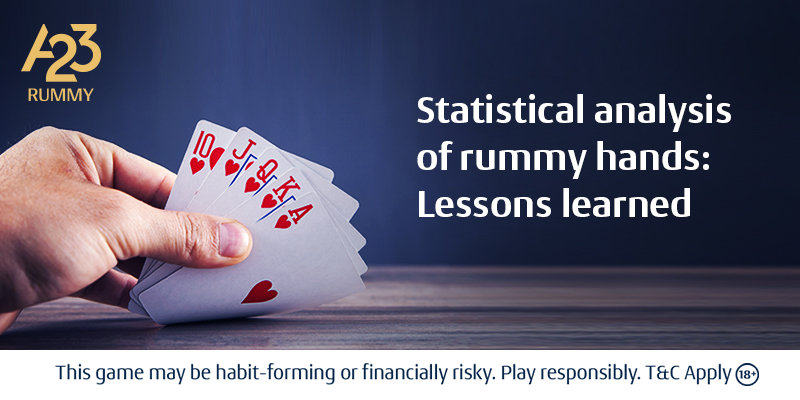
Rummy as a card game has gained immense popularity all over the country for being a thrilling game that involves skill and strategy. Its entertainment quotient is also accompanied by lessons in strategy and statistical analysis by understanding the cards in your hand and the ones your opponents discard. Winning rummy hands are a mix of probability, statistics and strategy. Find out why statistics matter when exploring how to play rummy.
How to Play Rummy: Analysis of Rummy Hands
At the beginning of the game, the players are dealt a hand of cards, also known as rummy hands and the remaining cards are placed on the table with one stack face down and one card face up, which will build the discard pile.
The objective of the game is to create sequences and sets. While learning how to play rummy, building winning rummy hands is based on sequences of cards that are arranged in ascending or descending order, all belonging to the same suit. Sets are three or four cards of the same value belonging to different suits.
Rummy Hands: Why do statistics matter?
Rummy rules dictate that in every turn, one must discard and pick up a card to achieve a low point total and complete their required sequences and sets. Considering this as the aim, the role of statistics comes into play right from the beginning, where you must estimate what the odds are of you getting a particular card or not getting a card.
Evaluating one’s own Rummy Hand
When you receive the hand that has been dealt to you, practice will teach you to observe the composition of the hand and understand how likely you are to form a sequence or a set with the cards you have.
Discard and Draw Probability of Rummy Hands
A game of rummy progresses only when players discard the cards from their rummy hands to try and make sets and sequences. In order to discard a card, they must statistically determine whether that card will help their game. Also, in order for a player to retain some cards in their hand, they must have a statistical understanding that they are likely to draw a card, whether from the face-down pile or the discard pile.
Predicting the Opponent’s Cards
When playing a game of rummy, keeping a careful watch on the cards that your opponents discard helps you predict what their rummy hands could contain and what sequences they are trying to make. This allows you to be careful with the cards you discard, so you do not end up helping your opponent win the game.
A knowledge of statistics helps you know that the game can keep shifting. Keeping a close watch on the rummy hands of other players can help you adjust your gameplan. This means that you keep your strategies flexible and ready to evolve as you draw more cards. This increases your chances with the creation of different rummy hands with the cards that are available.
While you follow the rummy rules, like in every game, strategy dictates a large part of the game. This means that as you play more games and practice with newer players and opponents, you can start forming a pattern of the kind of rummy hands that are required to win and start looking for these sequences when you are against others. Learning how to pick the best rummy hands includes making discards that could throw you off your game, even if they were just bluffing.
Play Rummy on the A23 App
Download the A23 rummy app and learn how to play rummy for an exciting game but also to improve your mental skills and strategic thinking. Develop concentration and focus that help you build your cognitive abilities while you sit down to enjoy a game of rummy. The game of rummy is fun while also being a great mental exercise.




 Apr 15, 2024
Apr 15, 2024
Note: that your message will not be displayed until it is reviewed by the moderator!